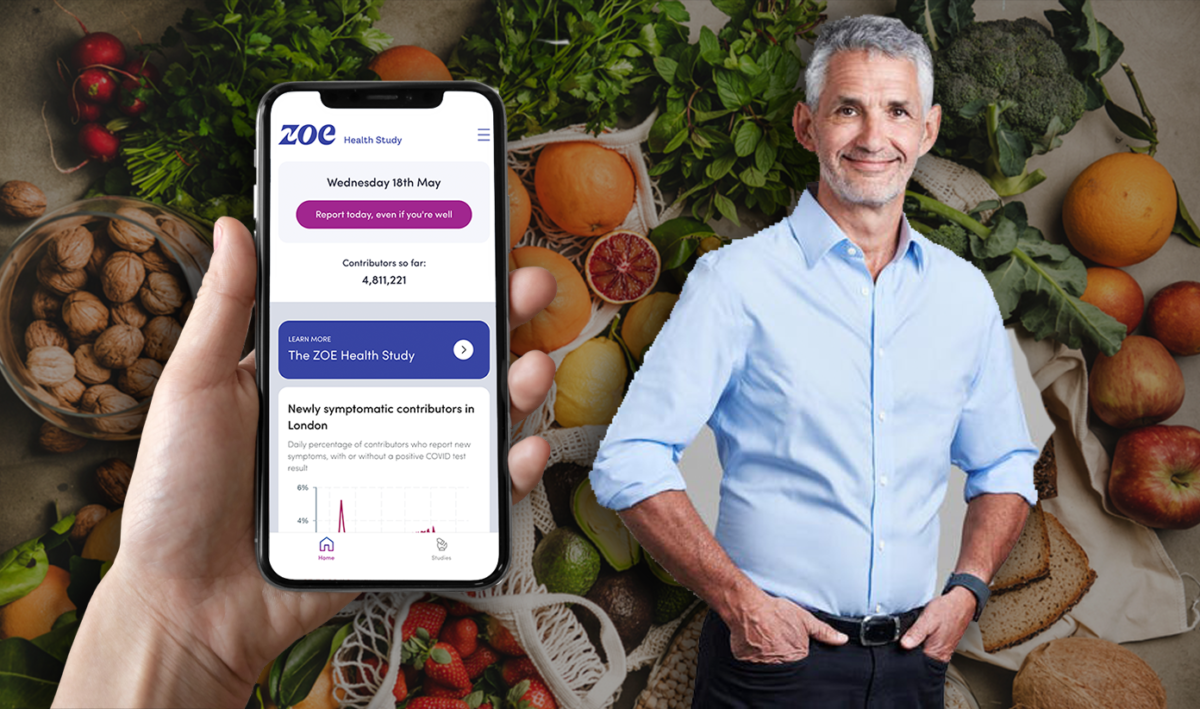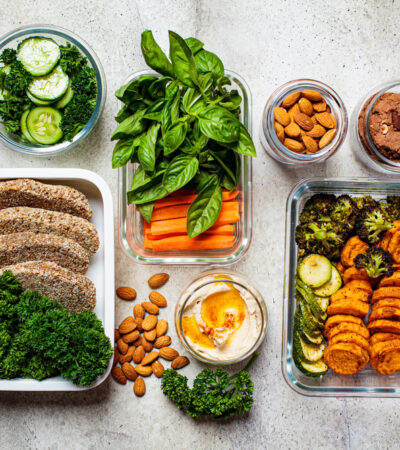H&H Contributor, Francesca gives her verdict on Tim Spector’s famous gut plan, ZOE, and shares what she learnt along the way.
I have been plagued by bloating for years. From the moment a morsel of food passes my lips, my stomach balloons and I look six months pregnant. In an attempt to resolve my bloating and heal my gut, I have tried every possible diet, consulted with dieticians, gastroenterologists and undergone numerous tests. I take various supplements, prescription medicine, exercise daily, practice time-restricted eating but to no avail; the bloating never ceases.
As a consequence, I have become obsessed with gut health. I am the biggest fan of Tim Spector, one of the world’s leading gut health scientists and Professor of Genetic Epidemiology at King’s College, London. Spector’s research into twins led to the discovery that identical twins only share 30% of the same gut microbiome and respond to the same food very differently. He discovered every single person has a unique gut microbiome which affects our responses to food and provides the key to our overall health.
Excitingly, Spector has co-founded the personalised nutrition programme ZOE with the aim to test every individual’s gut microbiome, their responses to food and deliver a personalised plan of how best to eat. Could this finally be a way to resolve my bloating and gut health? Of course, I sign up to find out!
The 2 Week Testing Period
I am delighted when my bright yellow ZOE box arrives through the post. In this box contains a blood sugar sensor (glucose monitor) which I will wear for the 2 weeks’ testing duration whilst also logging my food on the app, a gut health test (to test my stool), a finger prick blood test (to test my blood fat response) and a box of muffins (a controlled way to accurately test my responses to fat and sugar which will be measured against the rest of the ZOE community).
Day 1: Attach Glucose Monitor
Although attaching the monitor looks a little daunting, it’s relatively easy and doesn’t hurt.
The aim of using the glucose monitor is to check my glucose response to food, what impacts my response and how I feel. A fasting glucose level of below 5.6mmol/L is considered normal for people without diabetes. Eating will of course increase the levels of glucose in my blood but the main goal is to ensure there are no huge spikes; a level of 3.9-7.8mmol/L throughout the day is ideal. There are many variables which affect our blood glucose; our gut microbiome, genetics, exercise, our sleep, age, stress, menstrual cycle all play a part.
Having never given my blood glucose levels much of a thought before, I am amazed to see my own glucose levels and check them constantly throughout the day.
Alongside the testing, there are ZOE lessons and quizzes to take daily to learn more about the gut microbiome and how best to eat.
Day 2: Gut Health Test (Stool Test)
I think of the late Dame Deborah Jones and her lasting, ‘check your poo’ message. And honestly, it’s fine, ZOE provide disposable gloves, a flushable poo collection paper seat and a little scoop for the poop too!
For breakfast, I eat a big slice of melon and my blood sugar rockets to over 9. I’m shocked to see it rising so rapidly. For the rest of the day, my glucose levels form a series of peaks and troughs, far from ideal.
I begin reading Jessie Inchauspé’s book, The Glucose Revolution and follow her social media account @glucosegoddess. I am dumbfounded by how little I’d known until now about the impact of dramatic glucose spikes. Not only do extreme spikes cause those feelings of fatigue, they send us off on a glucose rollercoaster throughout the day; big spikes are followed by big dips and these make us want to eat more, especially sweet and sugary things. These spikes also cause inflammation, ageing us more rapidly. I think of my afternoon chocolate cravings in a very different light.
I discover that eating vegetables before a meal helps curb big spikes. Vegetables act as a mesh because they take longer to digest so eating these first will slow down the absorption of any subsequent simple starches and sugars like bread and chocolate which are normally digested quickly. This is also why food combining is so crucial, adding fats and proteins to carbs again helps slow down digestion.
Day 3: Muffin Testing
I’m feeling gung-ho for the big test day. The plan is; eat three muffins for breakfast, fast for four hours, eat two muffins for lunch, fast for two hours and then a finger prick blood test. Easy peasy I think.
The muffins are stodgy and taste artificially sweet. By the time I’ve eaten the first muffin, I’m struggling and find sipping black tea a welcome relief between mouthfuls. My children greedily eye up my plate in the hope for some last remnants, I’d gladly pass them over but I have to eat them all. I’m feeling sick by the time I’ve finished, I can safely say I’m feeling less gung-ho and I’m not looking forward to more muffins at lunch.
I’m relieved to see that my blood sugar levels haven’t done too badly and there is no dramatic peak at least.
Fast forward to lunchtime and the sight of more muffins makes me feel queasy. Thankfully this set of muffins are made from a different composition; they’re lighter and easier to eat and there are only two of them.
After the muffins, my blood sugar level quickly zooms up to almost 9. I’m quickly realising my blood sugar response can’t be very good.
The finger prick blood test hurts more than I’d expected but it’s fine and last I can eat! I’m hungry and end up eating far more than usual, even succumbing to a takeaway. I feel tired, sickly and grouchy with a bad headache.
I note my blood sugar is a spikey series of peaks and troughs. During the night my glucose levels fall below normal for a fair amount of time.
Day 4: Muffin Test
Thankfully I only need to eat the muffins for breakfast. I force them down as quickly as possible, I fast for three hours and then resume normal eating. Within a few hours, I feel terrible. I have the worst migraine, I can barely cook lunch, I feel sick and my head is pounding.
Interestingly, despite my symptoms, my blood sugar levels remain fairly constant. Probably because I don’t feel well enough to eat much.
Days 5-7: use a glucose monitor to test my response to my usual foods
I notice a trend; during the mornings my glucose levels are steady and I feel more energetic but after lunch, I have a dramatic spike and feel exhausted. I crave chocolate immediately after lunch and will eat something sweet. (One day I eat some Deliciously Ella caramel cups and my sugar levels rise to their highest; 10.9!) I begin to realise the impact of the sugar connection.
Oat milk, which I see as my ‘treat’ milk because it’s lovely and sweet causes my levels to spike to over 8 no matter when I consume it. I vow to stick to unsweetened almond, hazelnut, soya or normal full fat.
Days 8-12: try the ZOE blood sugar challenges
I am too busy trying to cram test all the food I normally eat so I choose not to attempt these. I already know I need to be careful with anything even remotely sweet! But exercising after eating can help reduce glucose levels, I stop sitting down after lunch and push myself to go out for a walk, it definitely helps to counteract the tiredness.
However, I am disheartened to realise I’ve only been able to keep my glucose levels in the ideal state for one day within the 14-day test period.
Day 14: End of Testing
The ZOE lessons continue daily and I try and up my plant intake. I’m learning a lot. I need to feed up my good gut bacteria by adding a diverse range of plants and fermented foods like kefir, yoghurt and kimchi. I have tended to restrict a lot of foods in the past like beans and pulses as these make my bloating worse but interestingly, the idea is to feed these microbes which will in turn increase their number and help with digestion. Avoidance only worsens my sensitivity. On top of this, improving my gut microbes will in turn help improve my blood sugar control.
Results: Dietary Inflammation Profile (muffin test)
This is provided in a scoring system to reveal how I compare to the rest of the people within the ZOE community. I score 52 for my blood sugar control, almost smack bang in the middle. I sneak into the ‘Good’ category but only just. I knew I wouldn’t score highly in this area but I’m surprised I’m so average.
I score a whooping 75 on my blood fat control which places me in the ‘Excellent’ category, I feel a little smug but I can’t help thinking I’d rather eat chocolate than cheese.
Results: Gut Microbiome (gut health test)
I’m given a list of all the bacteria present in my gut, including 30 key microbes broken down into the ‘good’ and ‘bad’ ones. I note I have a huge amount of the bad bacteria Edi (Eggerthella lenta), I wonder if Edi is causing my gut health symptoms, I’d quite like to get rid of him.
My gut diversity isn’t great, I only have 109 different species of gut microbes which places me in the lower 25% of the ZOE community. However, my ratio of good to bad gut microbes is what’s crucial and I score 74 which means I have a high level of good versus bad bacteria. The more good gut bacteria, the better our metabolism and blood sugar control will be alongside lower blood pressure and lower levels of the inflammatory marker GlycA.
The ZOE Food Scoring System
The results of both my sugar and fat control tests together with my gut health results are put together to create a personalised food scoring system. The scores are completely unique to me. The higher the score for food, the better it is for me. I swiftly pop onto the app and there are all my wonderful food scores. Wow! They are colour coordinated so it’s easy to tell at a glance how healthy a particular food is.
As I’ve been discovering, the magic is all about combining food properly. No food is off-limits and I’m able to use the app to view recipes, build meals and work out their score.
Learning and Thriving
The results do not signify the end of the ZOE plan, it’s only the beginning. Now I need to master eating according to my biology using my food scores and my daily lessons. I’ve got a long way to go yet.
My Thoughts
The whole ZOE process is fascinating: it has changed the way I eat and this in turn has improved the way I feel. I enjoy thinking about food in the ZOE way; to stabilise my sugar and fat levels whilst feeding up my good gut bacteria. I’ve never been one for calorie counting and thankfully ZOE isn’t about this either, it’s all about diversity and eating a wider range of health promoting foods. I’m much more careful about when I eat certain foods, I’ve stopped eating fruit on an empty stomach and I’ll try and have some carrots and hummus or a spinach salad before my main meal. It’s these little changes which are transformative. I no longer suffer from the terrible afternoon tiredness I once did. This is dramatic and has improved my days hugely.
As for my bloating? It hasn’t gone away but I now understand it’s a slow process and will likely improve as my gut health improves. I therefore no longer avoid the traditional ‘bloating’ foods in the hope that one day my gut will be diverse and healthy enough to tolerate these.
Sadly the programme will be cost prohibitive for many (the test kit alone is £259.99 and there is a membership fee on top of this). ZOE also doesn’t diagnose any diseases, its purpose isn’t medical but designed for overall health and general wellness. This means no allergies or intolerances are picked up (at least for now). But there are plenty of take-homes for everyone to adhere to regardless of their individual responses to food. I think the most useful are:
Eat fewer ultra-processed foods
Increase your vegetable, fruit, beans, legumes, nuts and seeds intake
Include probiotics such as kimchi, kombucha, sauerkraut and kefir
Do not eat simple carbs on their own
Eat vegetables or a salad before a meal
And finally, don’t count calories!
words by Francesca Londono-Richards – @wimbornemummy














